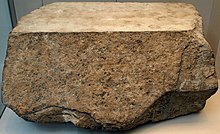
The Great Pyramid of Giza is the largest Egyptian pyramid and served as the tomb of pharaoh Khufu, who ruled during the Fourth Dynasty of the Old Kingdom. Built in the early 26th century BC, over a period of about 27 years, the pyramid is the oldest of the Seven Wonders of the Ancient World, and the only wonder that has remained largely intact. It is the most famous monument of the Giza pyramid complex, which is part of the UNESCO World Heritage Site "Memphis and its Necropolis". It is situated at the northern end of the line of the three pyramids at Giza.

The cubit is an ancient unit of length based on the distance from the elbow to the tip of the middle finger. It was primarily associated with the Sumerians, Egyptians, and Israelites. The term cubit is found in the Bible regarding Noah's Ark, the Ark of the Covenant, the Tabernacle, and Solomon's Temple. The common cubit was divided into 6 palms × 4 fingers = 24 digits. Royal cubits added a palm for 7 palms × 4 fingers = 28 digits. These lengths typically ranged from 44.4 to 52.92 cm, with an ancient Roman cubit being as long as 120 cm.

Sir William Matthew Flinders Petrie, commonly known as simply Sir Flinders Petrie, was a British Egyptologist and a pioneer of systematic methodology in archaeology and the preservation of artefacts. He held the first chair of Egyptology in the United Kingdom, and excavated many of the most important archaeological sites in Egypt in conjunction with his wife, Hilda Urlin. Some consider his most famous discovery to be that of the Merneptah Stele, an opinion with which Petrie himself concurred. Undoubtedly at least as important is his 1905 discovery and correct identification of the character of the Proto-Sinaitic script, the ancestor of almost all alphabetic scripts.
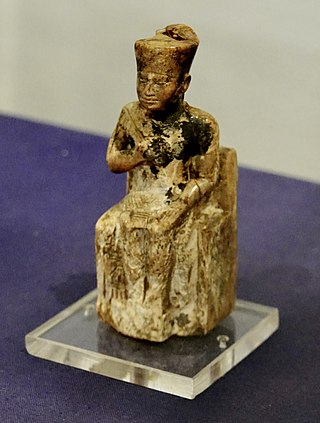
Khufu or Cheops was an ancient Egyptian monarch who was the second pharaoh of the Fourth Dynasty, in the first half of the Old Kingdom period. Khufu succeeded his father Sneferu as king. He is generally accepted as having commissioned the Great Pyramid of Giza, one of the Seven Wonders of the Ancient World, but many other aspects of his reign are poorly documented.
The pyramid inch is a unit of measure claimed by pyramidologists to have been used in ancient times.
Ancient Egyptian mathematics is the mathematics that was developed and used in Ancient Egypt c. 3000 to c. 300 BCE, from the Old Kingdom of Egypt until roughly the beginning of Hellenistic Egypt. The ancient Egyptians utilized a numeral system for counting and solving written mathematical problems, often involving multiplication and fractions. Evidence for Egyptian mathematics is limited to a scarce amount of surviving sources written on papyrus. From these texts it is known that ancient Egyptians understood concepts of geometry, such as determining the surface area and volume of three-dimensional shapes useful for architectural engineering, and algebra, such as the false position method and quadratic equations.

The pyramid of Khafre or of Chephren is the middle of the three Ancient Egyptian Pyramids of Giza, the second tallest and second largest of the group. It is the tomb of the Fourth-Dynasty pharaoh Khafre (Chefren), who ruled c. 2558−2532 BC.

The Giza pyramid complex in Egypt is home to the Great Pyramid, the Pyramid of Khafre, and the Pyramid of Menkaure, along with their associated pyramid complexes and the Great Sphinx. All were built during the Fourth Dynasty of the Old Kingdom of ancient Egypt, between c. 2600 – c. 2500 BC. The site also includes several temples, cemeteries, and the remains of a workers' village.

Pyramidology refers to various religious or pseudoscientific speculations regarding pyramids, most often the Giza pyramid complex and the Great Pyramid of Giza in Egypt. Some "pyramidologists" also concern themselves with the monumental structures of pre-Columbian America, and the temples of Southeast Asia.
The ancient Egyptian units of measurement are those used by the dynasties of ancient Egypt prior to its incorporation in the Roman Empire and general adoption of Roman, Greek, and Byzantine units of measurement. The units of length seem to have originally been anthropic, based on various parts of the human body, although these were standardized using cubit rods, strands of rope, and official measures maintained at some temples.

Meidum, Maydum or Maidum is an archaeological site in Lower Egypt. It contains a large pyramid and several mudbrick mastabas. The pyramid was Egypt's first straight-sided one, but it partially collapsed in ancient times. The area is located around 72 kilometres (45 mi) south of modern Cairo.

Hawara is an archaeological site of Ancient Egypt, south of the site of Crocodilopolis at the entrance to the depression of the Fayyum oasis. It is the site of a pyramid built by the Pharaoh Amenemhat III in the 19th century BC.

Menkare was an ancient Egyptian pharaoh, the first or second ruler of the Eighth Dynasty. Menkare probably reigned a short time at the transition between the Old Kingdom period and the First Intermediate Period, in the early 22nd century BC. The rapid succession of brief reigns at the time suggests times of hardship, possibly related to a widespread aridification of the Middle East, known as the 4.2 kiloyear event. As a pharaoh of the Eighth Dynasty, according to Manetho, Menkare's seat of power would have been Memphis.

The Rhind Mathematical Papyrus is one of the best known examples of ancient Egyptian mathematics. It is named after Alexander Henry Rhind, a Scottish antiquarian, who purchased the papyrus in 1858 in Luxor, Egypt; it was apparently found during illegal excavations in or near the Ramesseum. It dates to around 1550 BC. The British Museum, where the majority of the papyrus is now kept, acquired it in 1865 along with the Egyptian Mathematical Leather Roll, also owned by Henry Rhind. There are a few small fragments held by the Brooklyn Museum in New York City and an 18 cm (7.1 in) central section is missing. It is one of the two well-known Mathematical Papyri along with the Moscow Mathematical Papyrus. The Rhind Papyrus is larger than the Moscow Mathematical Papyrus, while the latter is older.
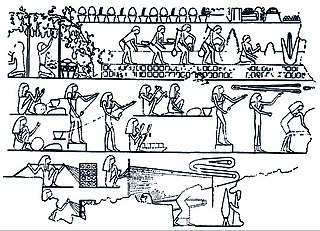
Ancient Egyptian technology describes devices and technologies invented or used in Ancient Egypt. The Egyptians invented and used many simple machines, such as the ramp and the lever, to aid construction processes. They used rope trusses to stiffen the beam of ships. Egyptian paper, made from papyrus, and pottery were mass-produced and exported throughout the Mediterranean Basin. The wheel was used for a number of purposes, but chariots only came into use after the Second Intermediate Period. The Egyptians also played an important role in developing Mediterranean maritime technology including ships and lighthouses.
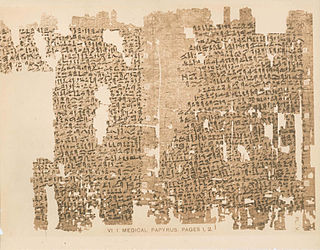
The Kahun Gynaecological Papyrus is the oldest known medical text in Egyptian history, dated to c. 1825 BCE, during the Twelfth Dynasty. The Papyrus addresses gynecological health concerns, pregnancy, fertility, and various treatments.

Egyptian geometry refers to geometry as it was developed and used in Ancient Egypt. Their geometry was a necessary outgrowth of surveying to preserve the layout and ownership of farmland, which was flooded annually by the Nile river.
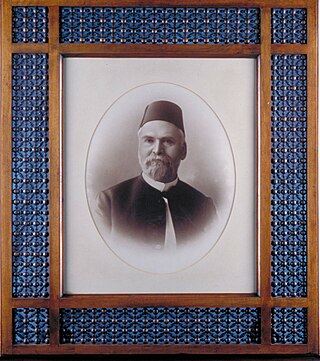
James Andrew Sandilands Grant (Bey) (1840–1896) was a Scottish physician and antiquarian. He was educated as a doctor of medicine at the University of Aberdeen in Scotland and then spent several years working in Egypt combatting outbreaks of cholera and working as a general practitioner. While he was there, he became well informed about the antiquities and culture of ancient Egypt and he went on to develop expertise in that field. He bequeathed a collection of his antiquities to the museum of the University of Aberdeen.



